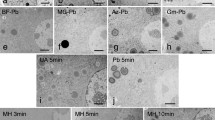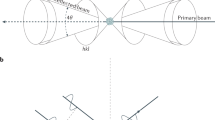Abstract
IT is well known that the development of a purple colour (Ruhemann's purple) on reaction of ninhydrin with primary amino (NH2) groups of proteins occurs even when the protein is not in solution. Thus, Pearse1 describes attempts to use the ninhydrin reaction for histochemical staining of protein, which failed due to the ease of diffusion of the coloured product. In fact, the soluble purple compound, to which formula (I) is usually assigned, is not in any way attached to the protein; it results from deamination of the protein (left otherwise unchanged), the abstracted nitrogen being incorporated in (I)2. Under suitable conditions, the coloured product is released completely from the solid into the solution, and the quantitative ninhydrin estimation, usually carried out on dissolved amino-acids and proteins, then becomes equally applicable to insoluble material. All primary NH2 groups react, ɛ-NH2 groups (lysine residues) giving, for reasons which are not certain, 65–70 per cent of the colour yield of α-NH2 groups, in almost all cases3. Where the former far outnumber the latter, as in tissue preparations and very many proteins, comparison with a standard gives the actual or relative amino content with fair accuracy. This appears to be the simplest method at present available for obtaining such information.
This is a preview of subscription content, access via your institution
Access options
Subscribe to this journal
Receive 51 print issues and online access
$199.00 per year
only $3.90 per issue
Buy this article
- Purchase on Springer Link
- Instant access to full article PDF
Prices may be subject to local taxes which are calculated during checkout
Similar content being viewed by others
References
Pearse, A. G. E., Histochemistry, 85 (J. and A. Churchill, Ltd., London, 1960).
For a recent review of ninhydrin chemistry, see McCaldin, D. J., Chem, Rev., 60, 39 (1960).
Slobodian, E., Mechanic, G., and Levy, M., Science, 135, 441 (1962).
Tallan, H. H., and Stein, W. H., J. Biol. Chem., 200, 507 (1953).
Moore, S., and Stein, W. H., J. Biol. Chem., 211, 907 (1954).
Kendall, P. A., and Barnard, E. A., J. Roy. Micro. Soc. (in the press).
Author information
Authors and Affiliations
Rights and permissions
About this article
Cite this article
KENDALL, P. Use of the Ninhydrin Reaction for Quantitative Estimation of Amino Groups in Insoluble Specimens. Nature 197, 1305–1306 (1963). https://doi.org/10.1038/1971305a0
Issue Date:
DOI: https://doi.org/10.1038/1971305a0
This article is cited by
-
Targeted tumour theranostics in mice via carbon quantum dots structurally mimicking large amino acids
Nature Biomedical Engineering (2020)
-
Nitrogen sources and CO2 concentration synergistically affect the growth and metabolism of tobacco plants
Photosynthesis Research (2020)
Comments
By submitting a comment you agree to abide by our Terms and Community Guidelines. If you find something abusive or that does not comply with our terms or guidelines please flag it as inappropriate.



